Live Long and Die Out
by Joe Veix
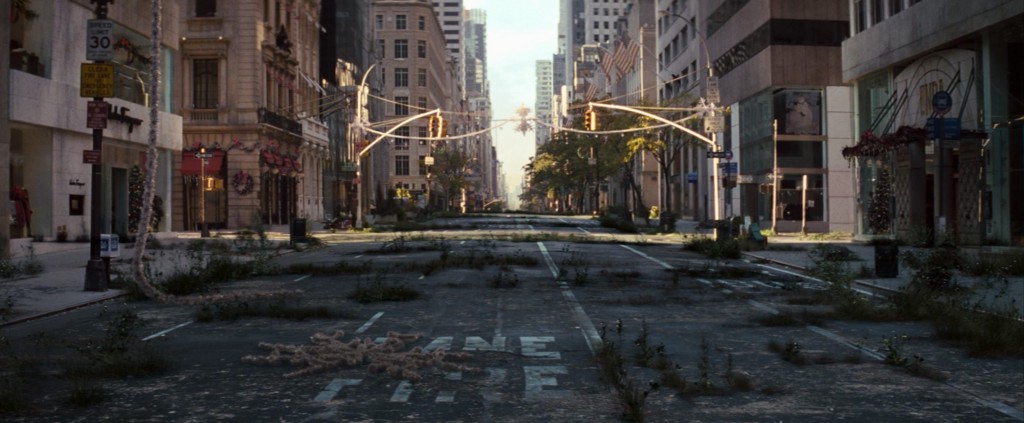
If you’re prone to flights of depressive thoughts in the shower (who isn’t?), you’ve perhaps briefly entertained the notion that, since humans are responsible for every environmental catastrophe, maybe the planet would be better off if we all just died. While you might rid yourself of such a bleak thought by making the water scalding and moving on to thinking about something cruel you did in middle school, there is a group of extremist hippies called the Voluntary Human Extinction Movement (VHEMT, pronounced “vehement”) that actively promotes the idea. Their philosophy is simple: Humans should stop breeding, and allow ourselves to go extinct. As their motto puts it, “Live long and die out.”
The movement was founded in 1991 by Les U. Knight, a substitute middle school teacher in Portland, OR. After working with the environmental group Zero Population Growth in the early seventies, he became disenchanted with their “stop at two” slogan, which he felt wasn’t drastic enough. He imagined a more effective alternative: stop at zero. The VHEMT, according to Knight, is not a “code of behavior to live by” and “it can’t get into arguments, tell people what to do and think, nor get punched for doing so.” It’s only concern is ceasing all human reproduction, to allow the environment to recover.
Knight claims that the idea has always existed in the private thoughts of a few enlightened people throughout history, and that he has merely provided a name and context for it. This is dubious, though many writers and organizations have raged against the environmental dangers of overpopulation: Thomas Malthus’s infamous An Essay on the Principles of Population was published in 1798; numerous population-focused groups formed in the sixties and seventies, including the shady1 Population-Environment Balance and Zero Population Growth; there’s a subreddit for overpopulation (of course there is) founded in 2009 with over ten thousand readers; and the Church of Euthanasia, run by Rev. Chris Korda2, who — following the instructions of an “alien intelligence known as The Being” — advocates for the suicide and cannibalism of everyone on earth. The VHEMT is the only serious organization committed to peacefully annihilating all of humanity.
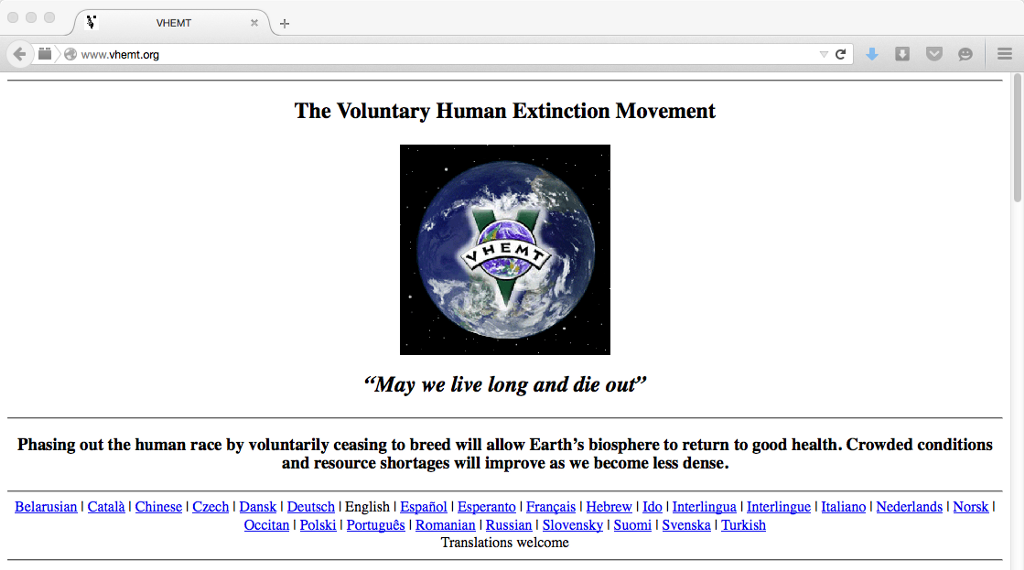
For those with reservations about supporting the extinction of humanity, most concerns are addressed on the VHEMT’s incredibly helpful website. Built in 1996 with little design changes since, it’s structured like a long FAQ. It’s also available in twenty-five languages, so good news if you speak Occitan.
Here are a few: Don’t you like babies? (Yes.) Are we all supposed to kill ourselves? (No.) Is this another one of those suicide cults? (No.) Didn’t Hitler have the same ideas? (No.) If there were a magic button for extinction, would you press it? (No.) Why don’t you just kill yourself? (Whoa.)
That last one is the most Frequently Asked Q.

Knight decided his best option for spreading his gospel pre-internet was by printing a zine. So in 1991, with little publishing experience, he started These Exit Times. He collected a few essays and comics (all written/drawn by him) and published them at a local print shop (I like to imagine an elderly store owner reading a few sentences with one eyebrow raised, and becoming extremely confused and upset). The zine reached roughly six hundred “volunteers” — most of whom discovered it after pieces in the New Age Journal and the zine guide Factsheet Five — by the time he printed its third and final issue in 1994. After that, he moved his operation online to save on printing and postage. Scans of each issue still exist online here, here, and here.
Though the zine’s title references the suicide manual Final Exit (published the same year) and is preoccupied with its goal of final mass death, its tone is surprisingly jocular. This is most evident in its charts and diagrams, most of them drawn by Knight himself. Take this timeline, for example, where “hooray!” signifies the death of all homo sapiens:
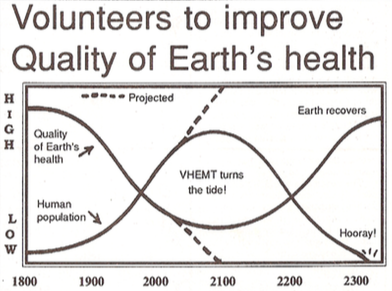
This is the “Path of Progressive Awareness” (which is not a little phallic?).
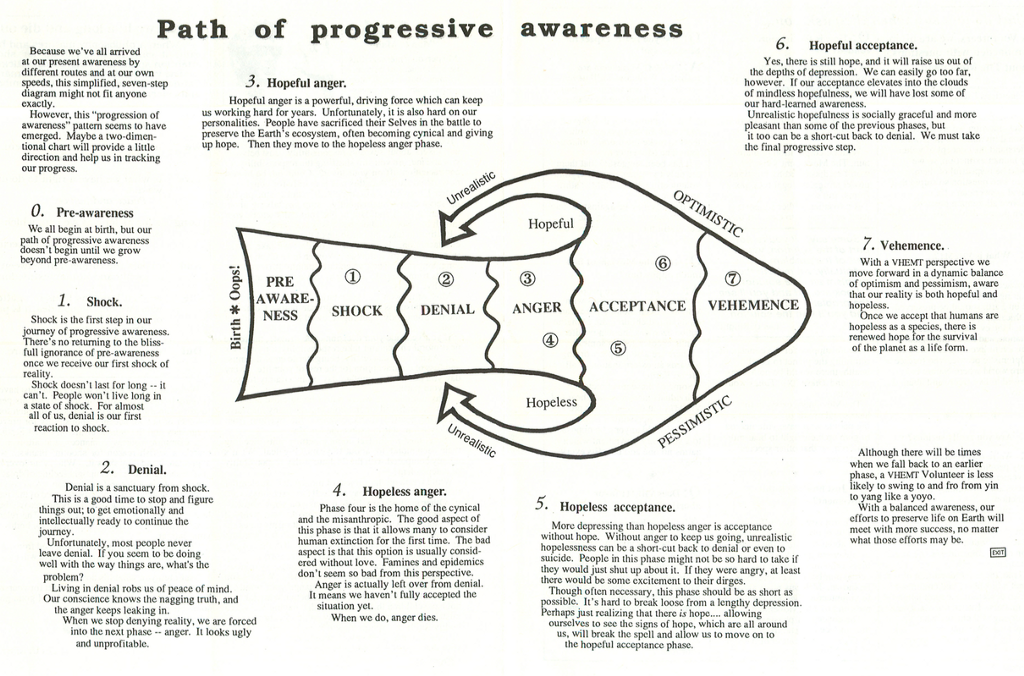
And this “eco depth guage” [sic] wouldn’t necessarily look out of place in Seventeen or BuzzFeed:
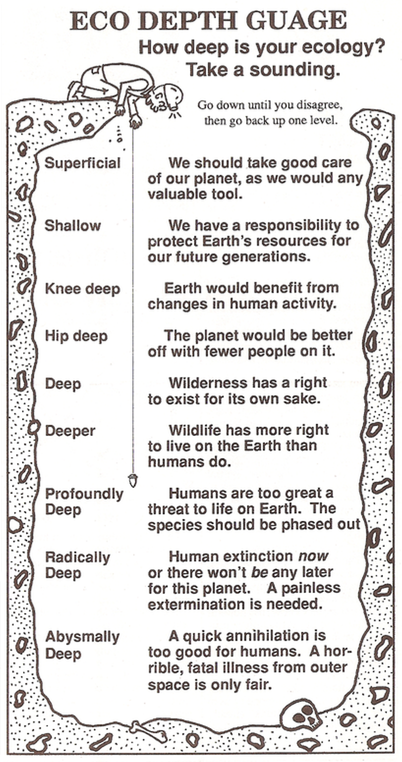
The issue includes a column from Les (called “Les Talk”), arguing for all men to get vasectomies. It closes with a polite letter to “non-members” of the movement. “No matter what you’re doing to improve life on planet Earth,” it reads, “I think you’ll find that phasing out the human race will increase your chances for success.” Overall, the first issue set the tone for the entire movement: A weirdly polite and upbeat expression of an oppressively dark worldview.
Issue Number Two (released in 1992) is largely a response to the first. It’s packed with reader mail, all of it supportive. One letter comes from someone named Tree Dream in Santa Cruz, CA: “Just so happens I’m with you, I-Bro.”
Deborah from Summertown, TN adds:
I was absolutely flabbergasted to be made aware of the VHEMT. I have long regarded humans as a parasitic infection on the planet […] and have only realized in the last decade that this world is utterly ravaged by hordes of greedy, inconsiderate, thoughtless two-legged beasts.
And Darryl from Richmond, VA comments:
I had a vision of mankind as a candle flame and the candle voluntarily slowly extinguishing it and going out. I think this ‘sacrifice’ could be considered the greatest moral act that people could accomplish, akin to the crucifixion in intensity, if not as dramatic.
Issue Two also attempts to get practical about accomplishing human extinction; there’s a long section listing other like-minded groups focused on reducing the population, though two of them are covert nativist organizations. The art also gets more bizarre. There’s a comic from the writer Kelpie Wilson, called “Bonobo Baby,” in which a woman cheerily gives birth to an ape.
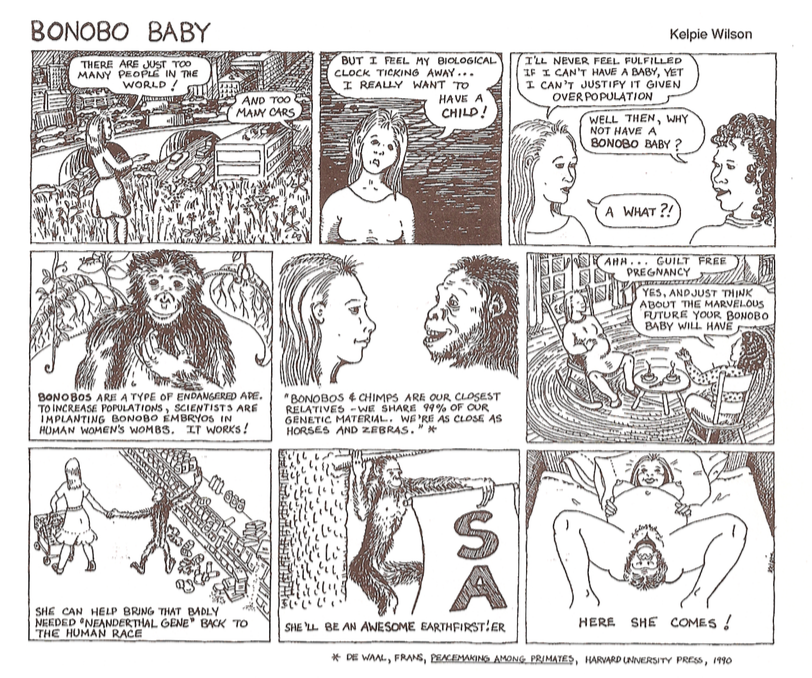
This convinces her friends to not have children (????).
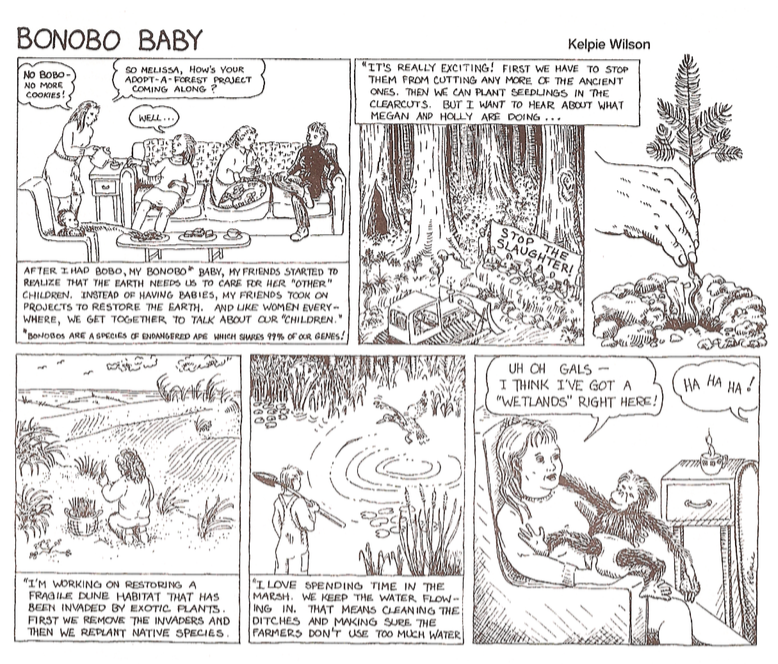
There’s an interview with the Gaia Liberation Front’s “spokesorganism” Geophilus, who serves to make the VHEMT actually seem reasonable by comparison. Geophilus supports involuntary sterilization, though he “would also welcome the escape of any new anti-human viruses — such as the airborne version of AIDS that might result from AIDS research on mice.”
And “Les Talk” returns with an article about abortion.
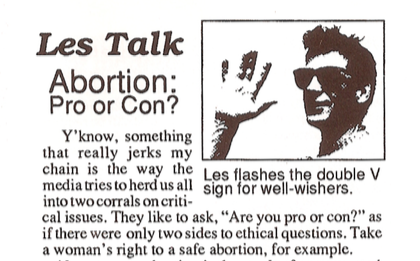
For the third issue, the structure of the full-color issue remained the same as before, including the usual essays, letters, and comics, but the production value went way up, thanks in part to cartoonist and animator Nina Paley. “[Her] art and comics made a huge improvement in the newsletters’ appearance,” Knight said. She provided illustrations and a comic to the issue (and later, created a few animated shorts).

There’s a prison letter from folk singer slash Earth First! activist Peg Millett, under a headline that sounds like a good Onion joke.
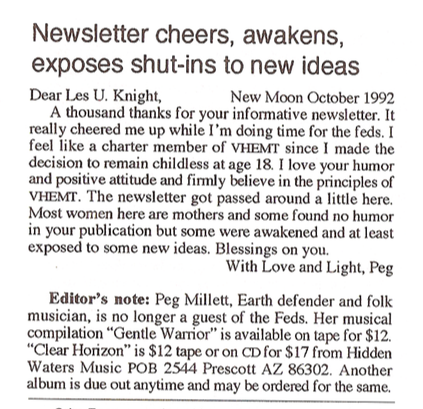
The issue also includes a Valentine’s Day contest to win a free vasectomy. Twenty-six men completed the following sentence on their entry form: “I want to tie the lover’s knot for my Valentine because…”
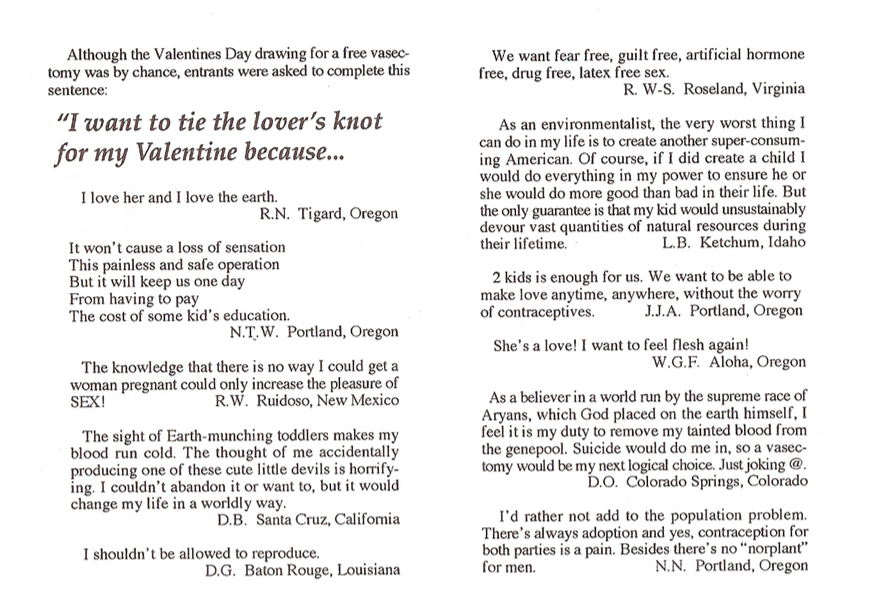
The final issue closes with a contraceptive pressure gauge.
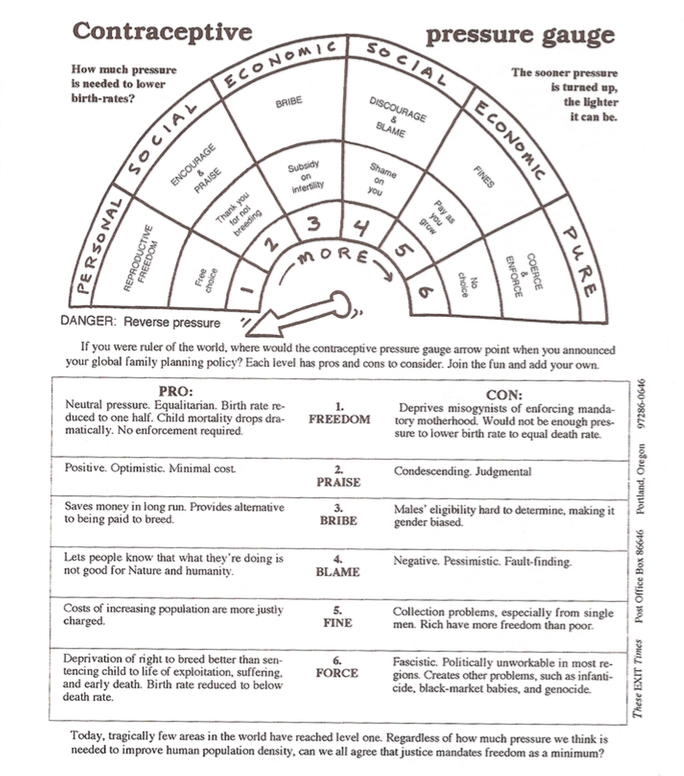
After the third issue, Knight killed These Exit Times. “It was time consuming and expensive,” he said, though he didn’t regret printing them. “The zines served their purpose well.” In their place, he created a website for the VHEMT. But, since a lot of humans still exist and are still having children (at least since I last checked), were the zines worth the trouble? “We’re spreading memes, not genes, so the more people who learn of VHEMT, whether they agree or not, it’s a success,” he said. “I’d like to think there are more than a few people who don’t exist thanks to our encouragement.”

Despite the fact that Knight seems like a genuinely nice, patient guy whose heart appears to be in the right place, there’s a relentless cynicism to his belief system: Humans are inherently destructive and evil; our world will inevitably be poisoned so long as we continue to exist; that any living being has more or less right to life than another, and we have the authority to determine this; and peacefully co-habiting with every other living being on our planet is impossible. The argument sounds like something from a mall goth, taking the most extreme, simplistic position to impress its friends.
If one wanted to dismiss the VHEMT’s arguments with a big condescending actually: The movement’s goals are rendered impossible by their own logic; if we are to assume that humans are so selfish/destructive that the earth is better off without us, it also holds that we’re too selfish/destructive to ever actually allow ourselves to die off. But let’s humor them.
Say, against all odds, that today, everyone on Earth agreed to allow humanity to die out, and the decision was reached peacefully and democratically. The last humans would be born roughly nine months from now. They’d probably become minor celebrities, and TV news shows would speculate about who the last person alive might be. At first, there wouldn’t really be any noticeable changes. But within twenty years, as about fifty-six million people die each year, the population would dip from seven billion to less than six billion; in forty years, less than five. Cities would slowly empty of people, as if they had sprung a leak. A quiet would gradually descend. Resources would be less scarce, for a time. It’d suddenly be easier to get a cab at rush hour in New York. At night, alarms would go off in the distance, from rusting cars belonging to no one.
In sixty years, some three-and-a-half billion people would remain. The youngest people in the world would be sixty years old. Infrastructure would have started to crumble. At some point, there wouldn’t be the critical mass of people required to maintain power plants and bridges and sewage treatment plants all at once. People would probably be too old to work to maintain them. Life would become more primitive. What would these remaining people be like? How much of our basic humanity is chained to the idea of survival and history, that once unmoored might drift completely away? What does it matter if you’re the last one left?
In eighty years, a little more than 2.3 billion people would remain, optimistically assuming a peaceful wind down. Maybe. Without infrastructure, and a supportive community of healthy people, and modern medicine, it’s hard to imagine people living beyond eighty. In any case, by this point, the population would very quickly crash.
Sometime within those few decades, the last person would collapse, unburied, leaving the Earth to rehabilitate. Before dying off, the last humans might build monuments, to commemorate how they made a noble choice to kill themselves to save the planet. In 7.2 million years, those monuments would fall apart, leaving no evidence that we ever existed. After that, based on the timeline of the far future: In eight hundred million years, all multi-cellular organisms would die out. In another seven billion years or so, the sun would expand in its red giant phase and obliterate the Earth. In 1010120 years, all the energy in the universe would extinguish, leaving an infinite void.
That’s the joke about the VHEMT: Regardless of when and how we leave, the ending’s always the same.
1. Many of these organizations were super racist — they were funded by John Tanton and U.S., Inc, and their environmentalism was just a guise to further a white supremacist agenda.
2. In 1993, Rev. Korda released a techno single, “Save the Planet, Kill Yourself.” Somehow, it never became a hit in clubs.
The Brand Circle of Life
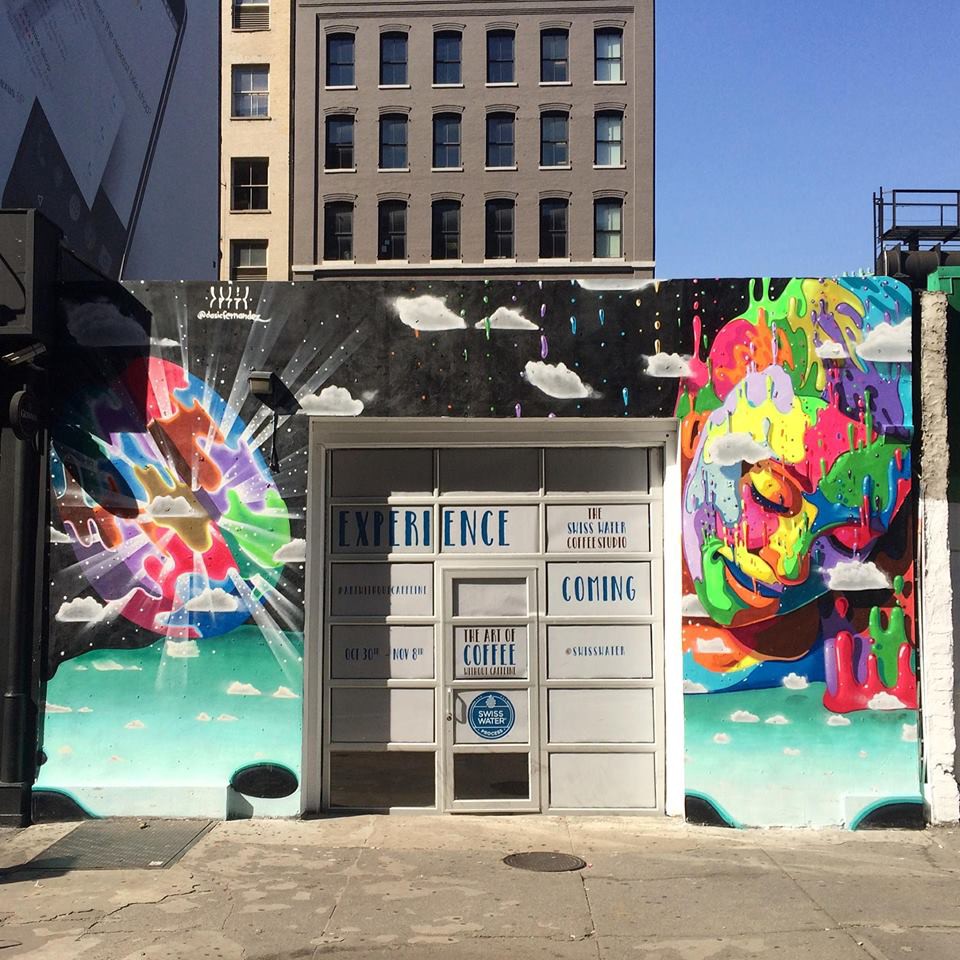
The isolated environments of islands often result in strange ecological outcomes. In the Galápagos, it produced giant tortoises; on the Indonesian island of Flores, a race of hobbits evolved; and on the island of Manhattan, human intervention and redevelopment has virtually wiped out the once-common gas station. But ecological niches are a funny thing, and decaying remains often prove to be fertile ground for new life: From the corpse of one gas station in SoHo, at 300 Lafayette Avenue, a tiny pop-up coffee shop has emerged.
But this Branded Cafe Experience is not like other Branded Cafe Experiences, because it is not advertising a product that you can buy, like Cafe Bustelo, a “bold blend…roasted and ground from the finest coffees in the world” with “no fancy equipment needed.” No, the Swiss Water® Coffee Studio, where you are “invited to experience the Art of Coffee Without Caffeine,” is attempting to turn a decades-old industrial decaffeination process into a Brand. It is a pure Branding exercise because the caffeine-averse consumer cannot Swiss Water® decaffeinate their coffee, they can only look for the Swiss Water® Brand on bags of already roasted coffee. The essence of this Brand is that this decaffeination process is superior to others because it doesn’t use chemicals and is organic — coffee beans are soaked in old coffee water repeatedly to get the caffeine out while maintaining a semblance of the coffee’s original flavor — and if a fancy coffee roaster offers decaf, it has almost certainly gone through the Swiss Water® process.
The Swiss Water® process is in fact, “the world’s only branded decaffeination process,” according to the Ten Peaks Coffee Company, the Canadian company which owns “all of the interests of the Swiss Water Decaffeinated Coffee Company Inc.” and is traded on the Toronto Stock Exchange. Since the Swiss Water® Coffee Studio opened on Friday, Ten Peaks’ stock has dropped ever so slightly, but there’s still a whole week left to experience its Brand, and the outlook for the company and its Brand is quite strong:
We have been successful in establishing our brand as a leading chemical free processor of green decaffeinated coffee. We actively support our brand through targeted regional media, print, public relations and event marketing, and via in-store communications. As a result, consumers and participants in the coffee trade are increasingly aware of the chemical free SWISS WATER® Process and the value it delivers through superior quality and taste. We believe there is significant potential to continue to broaden consumer awareness of the benefits of the SWISS WATER® Process.
But the Swiss Water® Coffee Studio is merely a beautiful cocoon for the Brand that will one day emerge at 300 Lafayette, an eighty-thousand-square-foot “FLAGSHIP RETAIL AND BOUTIQUE OFFICE DEVELOPMENT AT THE PRIMARY GATEWAY TO SOHO,” whose “DESIGN IS INSPIRED BY PRINCIPLES OF ‘BIOPHILIA,’ MEANING PEOPLE FEEL GOOD WHEN THEY ARE CONNECTED TO NATURE” which will make it an “ICONIC BUILDING [that] REPRESENTS AN EXTRAORDINARY OPPORTUNITY FOR A WORLD CLASS INTERNATIONAL BRAND.”
The Brand Circle of Life is never broken.
Photo by Swiss Water Coffee Studio
A Smartphone Raised My Baby

What’s new in the world of parenting?
One-third of the parents of 3- and 4-year-olds said their children liked to use more than one device at the same time, noted Dr. Hilda Kabali, a pediatrician and the lead author of [a survey on the exposure and use of mobile media devices by young children.] Seventy percent of the parents reported allowing their children, ages 6 months to 4 years old, to play with mobile devices while the parents did housework, and 65 percent said they had done so to placate a child in public. A quarter of the parents said they left children with devices at bedtime, although bright screens disrupt sleep… According to the parents, nearly half of the children younger than 1 used a mobile device daily to play games, watch videos or use apps. Most 2-year-olds used a tablet or smartphone daily.
Who knows what this all could mean? You will no doubt see efforts to discredit the study because of its small size, and there will also be the routine attempts to dismiss its concerns as overblown tech panic. That is, I suppose, fair enough. But please do not fall for the usual claims that this is just as meaningless as the worries that a generation of parents were using television as a babysitter, because you know what? The first generation of children who were babysat by television were the Boomers, and they are indisputably America’s most selfish and terrible cohort. They broke the country beyond repair and are still sucking out the last bits of blood on their way out the door. They fucked everything up, stuck us with their awful music, commodified nostalgia to an extent that is still almost incomprehensible, valorized avarice and self-regard to the point where they are now aspirational attributes, and won’t even die without draining whatever tiny shreds of hope and dignity remain to the nation, all the while wondering what we’re so upset about because everything seems fine to them. Can a generation of children who were denied human contact so that their parents could be left alone to play on their own phones and tablets be any worse? (Maybe, but what does it matter? Everything’s falling to shit anyway and the best these kids can hope for is that the robots eat them before they burn up in the terrible fires they will all be running from soon enough. Have you talked to the average parent lately? Children are better off being raised by Pew Die Pie.) What difference does it make, really, is what I’m saying. There’s nothing but terror ahead. Let the toddlers have their phones.
Photo: Shutterstock.com
Lowly, "S.W.I.M."
And here we are. You looked out yesterday at the low light of the late afternoon and you realized that even the warm weather we’re having this week won’t conceal the sadness of the season once you walk out of work into total darkness tonight. You’re in it. The dying leaves and fading sun tell you all you need to know. The holidays will come and you’ll float through those on a river of alcohol and a raft of pills but you will still wash up on the shore of January empty and alone and unprepared once more to face a winter that lasts for four months after (if you’re lucky). You had a good run and you may have even convinced yourself to forget that it would ever end, but winter can only be kept at bay for so long and once the clocks go back the door opens and in it strolls, sitting down at your table and settling in with a smile, saying only, “And here we are.” While you adjust, enjoy some rot and decay from Lowly, whose new EP is one of the most impressive debuts of the year.
New York City, October 29, 2015
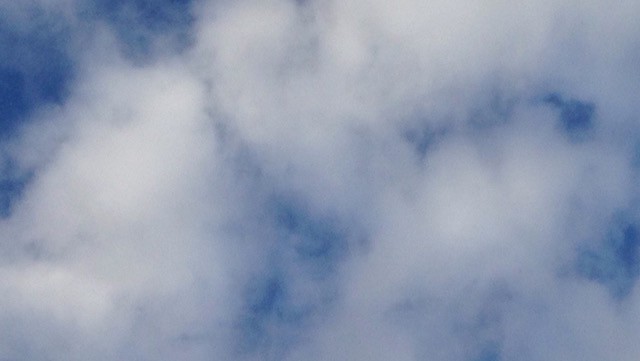
★★★★ Flecks of bright yellow gleamed on windows here and there in the gray landscape. More yellow bloomed; the gray scattered and fled east. A stagey patch of reflected sun drew the eye to someone passing out fitness-center handbills. More clouds arrived and went away again. The door rattled in its frame as the breeze blew in the window, and the tilt wand on the blinds swung out the opening. The unimpeded sun stretched a golden curtain of streaks and grime across the window glass. The wind had found some sweet spot in the building and was screaming against the door. Everyone was in a mood. At the very bottom western edge of the otherwise impassive blue sky, a purple and orange sunset condensed. It shrank even further to a wild fluorescent magenta, visible only if you went to the right spot and looked for it.
The True Story of Good Coffee
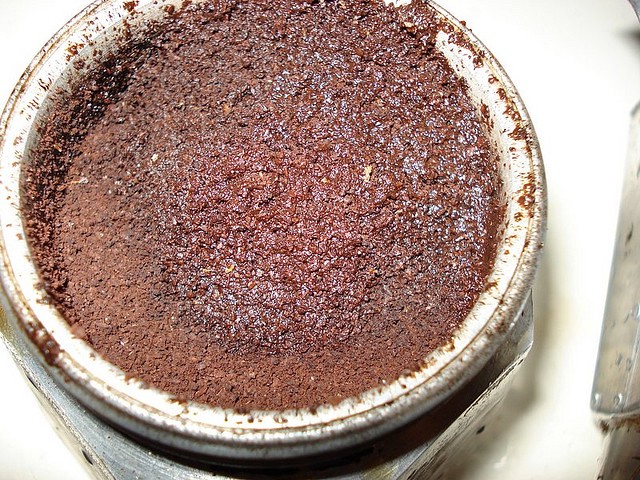
There was a time not so long ago when all of the coffee in the entire United States of America was bad. It only came in giant cans and it was roasted and ground until it tasted like dirt and no one who drank it knew where any of it came from or even cared because it was very cheap and all of the coffee farmers were very sad. But then in 1966 there was a man, because of course it was a man, and he realized that if he made the coffee a little bit better by roasting it darker he could charge more for it, and his name was Alfred Peet. And then in 1971 there were some other men, and they talked to Alfred, and one of those men went by the name of Howard Schultz, and he made sure that everybody in America was awakened by the ancient Italian coffee known as the Frappuccino. A couple of decades later, in 1995, there was another a man but also a woman, and their names were Doug Zell and Emily Mange, and they decided that they would buy coffee directly from coffee farmers and not blend it with coffee from other farmers and that also they wouldn’t roast it all that dark, so you could taste the flavors of the actual farm where this “single-origin” coffee came from, sort of like wine, which costs a lot of money, and maybe coffee could cost that much too, and they called their coffee Intelligentsia. Other men, like a man in Portland named Duane Sorenson, thought that Good Coffee was a Good Idea, but he could make it Better, so in 1999, he went to the countries where they farm the coffee and took a lot of pictures and posted them online and said things like, “I don’t want to sell my coffee to everyone… It’s not for everyone. I don’t have the fucking time for it, man.” It was like a whole Wave of coffee, and I guess that is when the coffee became Good and many people in many cool cities drank it, or at least that is how the story goes.
Over the next few years, a lot of other foods, meat and vegetables and alcoholic beverages alike, became Good too — sustainably raised, ethically uprooted, hand-slaughtered, locally bartered — and a whole lot of people with a lot of money decided that they really liked Good Food, especially as a way to show how they were better than other people with a lot of money. This made the people who were making the Good Coffee think, “Wow, a lot more people could be drinking our Good Coffee, which is currently only a mediocre capitalist venture with marginal profits,” even though they had three or six or ten stores and were selling a good amount of coffee to cafes and restaurants who wanted to serve their Good Coffee. Some people with money, mostly but not entirely men, called venture capitalists, or investors for short, agreed with them, and started giving some of the coffee men money to expand. In 2011, a company called TSG, which had previously given the world VitaminWater, bought most of Stumptown, which had realized that while it would be cool to open roasteries and cafes all over the country, it would be even cooler to sell its Good Coffee to a LOT more people, so they put it in retro-style glass bottles and in cute cartons with milk and sugar and, more recently, in nitro cans and giant kegs, which could be marketed as “cold brew on tap” and sold all over the place, so customers didn’t have to bother with any of the things that make brewing Good Coffee so annoying. And things were Pretty Good.
At the same time, in San Francisco, another coffee man, named James Freeman, had started a Good Coffee company called Blue Bottle. One of things that made his coffee company different is that in addition to selling his Good Coffee out of beautiful shops, it was based in San Francisco at a time when there were a lot of men with a lot of money and a lot of taste — because they made apps, or gave money to other men to make apps, in order to change the entire world (which requires a lot of discernment). These tasteful app men loved Blue Bottle so much they gave it twenty million dollars, and then twenty-five million dollars, and finally seventy million dollars (that’s over a hundred million dollars), so that their favorite coffee company could grow — “scale” — just like their favorite app companies, and acquire millions of users and change the world with Good Coffee. Blue Bottle took that money and acquired some other, smaller Good Coffee companies and a famous San Francisco bakery and it opened some more coffee shops and it sold lots and lots of cute Good Coffee cartons and it even acquired a company that will let it sell Good Coffee in every grocery store in every city in America. Wow. Every other Good Coffee company suddenly looked very small next to Blue Bottle’s big pile of money. This made some of them decide to raise money too, and because venture capitalists do not want to miss a good opportunity to venture their capital in order to acquire more of it, they gave millions of dollars to other companies that they thought might have Good Coffee, like La Colombe Torrefaction, and even obviously not-so-good coffee companies like Philz Coffee .
Meanwhile, in a land far away, called Europe, there is a company called JAB Holding Company. It owns a lot of other companies, like Jimmy Choo, and many of its companies own companies of their own. A lot of these companies that its companies own are coffee companies with Fine Brands, like Caribou Coffee, Espresso House, Baresso Coffee, Tassimo, Senseo, Gevalia, and many others. In 2012, the year that the app men started giving money to Blue Bottle, one of JAB’s companies bought Alfred Peet’s Fine Coffee company, Peet’s Coffee & Tea.
A few months ago, for reasons that are still not clear, but perhaps because Stumptown was not “scaling” fast enough to become the next VitaminWater (maybe because Duane Sorensen became a restaurant man, and not so much of a coffee man anymore, or at least that is what many other coffee men and women say, but who knows) TSG decided to sell its stake in Stumptown, and a few weeks ago, Peet’s decided to buy it, because it was a Good Coffee Brand whose readymade cold brew would be easy to scale. That same week, it became public that Intelligentsia, after twenty years in business — some of which were financially rocky, according to many coffee men and women, despite making it all the way to Los Angeles and New York from Chicago — put itself up for sale or a lot of investment, whatever. Peet’s decided to buy it, too, because while it owned a lot of Fine Coffee Brands, it could always use another Good Coffee Brand.
There are perhaps some people who will be upset that their favorite Good Coffee Company is now just another Good Coffee Brand, revealing once again the insignificance of their person and the futility of their Brand Devotion when it is set against forces vastly larger than themselves, like capitalism, but they should take solace in the fact that even if the Good Coffee Brand becomes less Good as it becomes ever larger — which, FWIW, Blue Bottle has only gotten better as it has gotten bigger — it was never even Great to begin with. It was just coffee.
Photo by Alexandre Enkerli
Hieroglyphic Being & J.I.T.U. Ahn-Sahm-Buhl, "Fuck The Ghetto/Think About Outer Space"
The music that accompanies this track may not be to your taste but the video itself is astounding. Have a look.
Sofie Winterson, "I Only Wanted You"
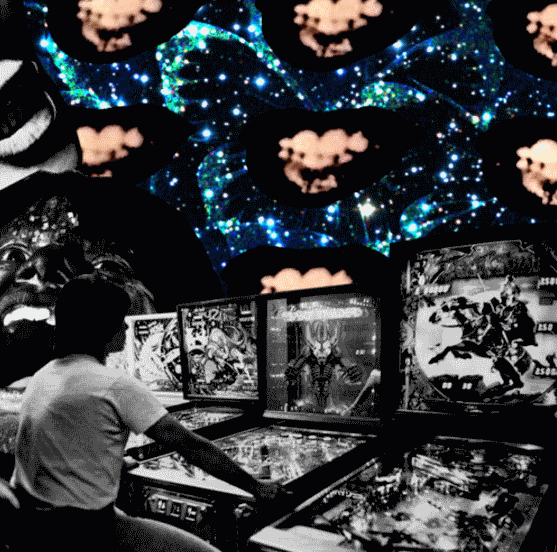
The road ahead is ragged and the track you take gets tough, but at least today is Friday. That will have to be enough. Also, this song is a certified goddamn delight, so it’s not all nightmares and regret in your future. It’s just mostly nightmares and regret. Enjoy.
New York City, October 28, 2015
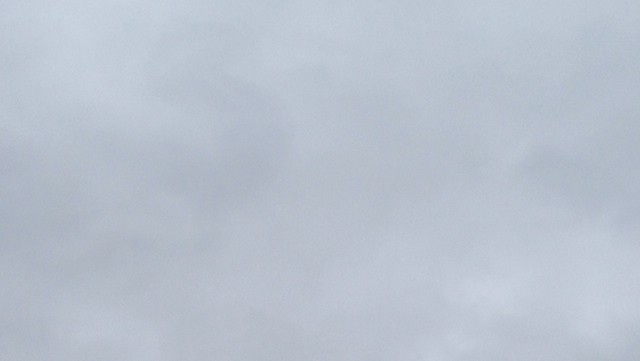
★ It was still nighttime, the four-year-old complained, heading late out the door in his boots and rain jacket. It didn’t seem fair to tell him he was wrong, as bits of drizzle fell in the gloom. The drizzle became rain. The trees were not far enough along for this to be the storm that would wipe out the leaves and the color. “Umbrella, umbrella, umbrella,” chanted a man with a cartload at the top of the subway steps. Umbrellas, their raising and lowering, clogged and stalled the flow of people. Sometime in the afternoon, whatever tenuous daylight had been established ran out. In the four o’clock hour, a streetlight shone off the parking lot sign out the office window. The driving rain became dripping rain. Clouds erased a quarter billion or half a billion dollars in real estate from the top of One57. In the old hard-surfaced school auditorium, the air conditioner made a heavy racket for a while, then shut off, leaving the air thick and damp. Hours later, the meeting let out into what seemed to be nothing more than a few wayward drops of rain — and then a spray of rain, and moments later a downpour washing over the sidewalks, sending little white fountain jets arcing into the storm drain from the surging flood in the gutters. Maybe half of the six-block course to home was scaffolded; it was not enough.
